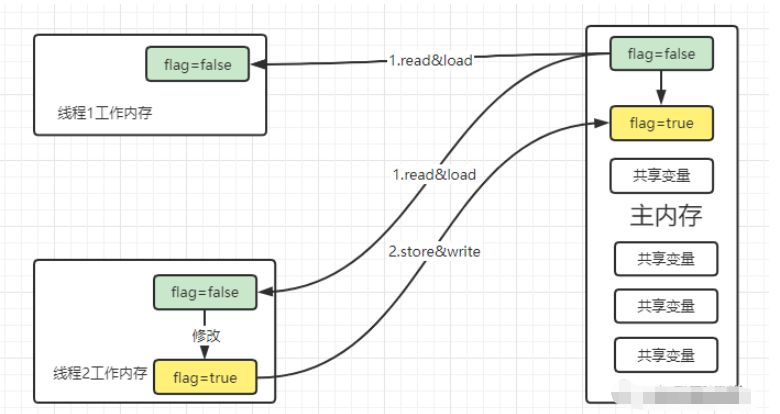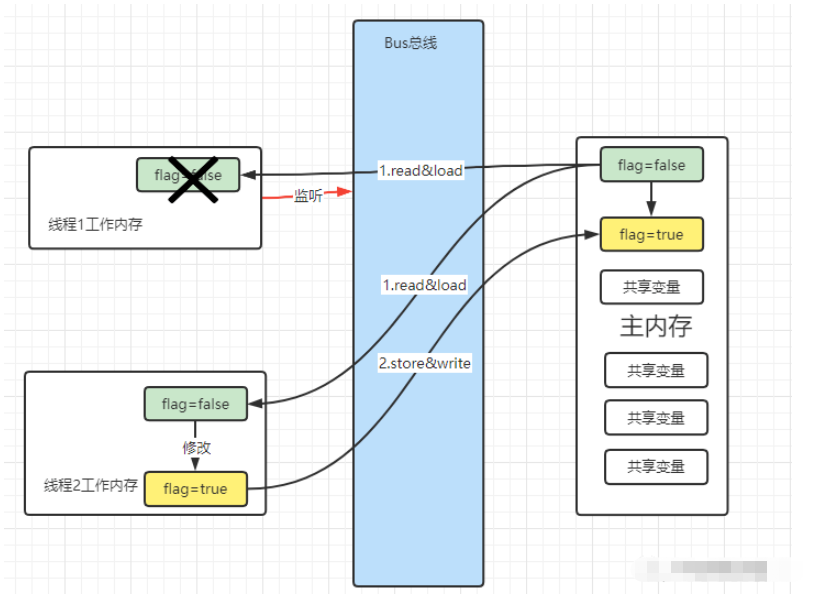 Java
Java
 javaTutorial
javaTutorial
 Example analysis of volatile and JMM multi-threaded memory model of Java concurrent programming
Example analysis of volatile and JMM multi-threaded memory model of Java concurrent programming
Example analysis of volatile and JMM multi-threaded memory model of Java concurrent programming
1. See the phenomenon through the program
Before we start to explain the Java multi-threaded cache model, let’s first look at the following code. The logic of this code is very simple: the main thread starts two sub-threads, one thread 1 and one thread 2. Thread 1 executes first, and thread 2 executes after sleeping for 2 seconds. The two threads use a shared variable shareFlag, with an initial value of false. If shareFlag is always equal to false, thread 1 will always be in an infinite loop, so we set shareFlag to true in thread 2.
public class VolatileTest {
public static boolean shareFlag = false;
public static void main(String[] args) throws InterruptedException {
new Thread(() -> {
System.out.print("开始执行线程1 =>");
while (!shareFlag){ //shareFlag = false则一直死循环
//System.out.println("shareFlag=" + shareFlag);
}
System.out.print("线程1执行完成 =>");
}).start();
Thread.sleep(2000);
new Thread(() -> {
System.out.print("开始执行线程2 =>");
shareFlag = true;
System.out.print("线程2执行完成 =>");
}).start();
}
}If you have not learned the JMM thread model, maybe after reading the above code, you hope that the output result is as follows:
Start executing thread 1 => Start executing thread 2 => Thread 2 execution is completed => Thread 1 execution is completed =>
As shown in the figure below, normal people understand this code. First execute thread 1 and enter the loop. 2 Modify shareFlag=true, and thread 1 jumps out of the loop. Therefore, thread 1 that breaks out of the loop will print "Thread 1 execution completed =>", but after the author's experiment, **"Thread 1 execution completed =>" will not be printed, and thread 1 does not break out of the infinite loop**. This Why?

2. Why does this phenomenon occur (JMM model)?
To explain the problems mentioned above, we need to learn the JMM (Java Memory Model) Java memory model. I think it is more accurate to call it Java multi-threaded memory model.

First of all, in JMM, each thread has its own working memory. When the program starts, the thread loads the shared variables (read&load) into In its own working memory, the memory variables loaded into the thread's working memory are copies of the shared variables in the main memory. That is to say, there are three copies of shareFlag in memory at this time, and their values are all equal to false.
When thread 2 executes
shareFlag=true, its working memory copy is modified toshareFlag=true, and the value of the copy is synchronized at the same time Write back (store&write) to main memory.But
shareFlag=falsein the working memory of thread 1 has not changed, so thread 1 has been in an infinite loop. middle.
3. MESI cache coherence protocol
The modification of shared variables by thread 2 will not be perceived by thread 1, which is consistent with the above experimental results and JMM model. So how can thread 1 perceive that the value of the shared variable has changed? In fact, it is very simple. Just add the volatile keyword to the shareFlag shared variable.
public volatile static boolean shareFlag = false;
The underlying principle is like this. Adding the volatile keyword prompts JMM to follow the MESI cache consistency protocol. The protocol contains the following cache usage specifications (If you don’t understand it, you can ignore it. It will be used below. Describe it in simple language and examples).
Modified: Represents that the data of the current cache line is modified (Dirty), and is only modified in the cache of the current CPU; at this time, the The data in a cache row is different from the data in other caches and different from the data in the row in memory.
Exclusive: Indicates that the data of the current Cache line is valid data, and there is no such line of data in the cache of other CPUs; and the data of the current Cache line is different from the data in the memory. same.
Shared: This line of data will be cached in the Cache representing multiple CPUs, and the data in the Cache is consistent with the data in the memory;
Invalid: Indicates that the data in the current Cache line is invalid;

The cache above The usage specification may be too complicated. To put it simply,
When thread 2 modifies shareFlag (refer to Modify), inform the bus that I have modified the shared variable shareFlag,
Thread 1 monitors the Bus. When it learns that the shared variable shareFlag has been modified, it will delete the copy of shareFlag in its working memory to render it invalid.
When thread 1 needs to use shareFlag again and finds that there is no copy of the shareFlag variable in the working memory, it will reload (read&load) from the main memory
The above is the detailed content of Example analysis of volatile and JMM multi-threaded memory model of Java concurrent programming. For more information, please follow other related articles on the PHP Chinese website!

Hot AI Tools

Undresser.AI Undress
AI-powered app for creating realistic nude photos

AI Clothes Remover
Online AI tool for removing clothes from photos.

Undress AI Tool
Undress images for free

Clothoff.io
AI clothes remover

Video Face Swap
Swap faces in any video effortlessly with our completely free AI face swap tool!

Hot Article

Hot Tools

Notepad++7.3.1
Easy-to-use and free code editor

SublimeText3 Chinese version
Chinese version, very easy to use

Zend Studio 13.0.1
Powerful PHP integrated development environment

Dreamweaver CS6
Visual web development tools

SublimeText3 Mac version
God-level code editing software (SublimeText3)

Hot Topics
 1665
1665
 14
14
 1424
1424
 52
52
 1322
1322
 25
25
 1270
1270
 29
29
 1250
1250
 24
24
 Break or return from Java 8 stream forEach?
Feb 07, 2025 pm 12:09 PM
Break or return from Java 8 stream forEach?
Feb 07, 2025 pm 12:09 PM
Java 8 introduces the Stream API, providing a powerful and expressive way to process data collections. However, a common question when using Stream is: How to break or return from a forEach operation? Traditional loops allow for early interruption or return, but Stream's forEach method does not directly support this method. This article will explain the reasons and explore alternative methods for implementing premature termination in Stream processing systems. Further reading: Java Stream API improvements Understand Stream forEach The forEach method is a terminal operation that performs one operation on each element in the Stream. Its design intention is
 PHP: A Key Language for Web Development
Apr 13, 2025 am 12:08 AM
PHP: A Key Language for Web Development
Apr 13, 2025 am 12:08 AM
PHP is a scripting language widely used on the server side, especially suitable for web development. 1.PHP can embed HTML, process HTTP requests and responses, and supports a variety of databases. 2.PHP is used to generate dynamic web content, process form data, access databases, etc., with strong community support and open source resources. 3. PHP is an interpreted language, and the execution process includes lexical analysis, grammatical analysis, compilation and execution. 4.PHP can be combined with MySQL for advanced applications such as user registration systems. 5. When debugging PHP, you can use functions such as error_reporting() and var_dump(). 6. Optimize PHP code to use caching mechanisms, optimize database queries and use built-in functions. 7
 PHP vs. Python: Understanding the Differences
Apr 11, 2025 am 12:15 AM
PHP vs. Python: Understanding the Differences
Apr 11, 2025 am 12:15 AM
PHP and Python each have their own advantages, and the choice should be based on project requirements. 1.PHP is suitable for web development, with simple syntax and high execution efficiency. 2. Python is suitable for data science and machine learning, with concise syntax and rich libraries.
 PHP vs. Other Languages: A Comparison
Apr 13, 2025 am 12:19 AM
PHP vs. Other Languages: A Comparison
Apr 13, 2025 am 12:19 AM
PHP is suitable for web development, especially in rapid development and processing dynamic content, but is not good at data science and enterprise-level applications. Compared with Python, PHP has more advantages in web development, but is not as good as Python in the field of data science; compared with Java, PHP performs worse in enterprise-level applications, but is more flexible in web development; compared with JavaScript, PHP is more concise in back-end development, but is not as good as JavaScript in front-end development.
 PHP vs. Python: Core Features and Functionality
Apr 13, 2025 am 12:16 AM
PHP vs. Python: Core Features and Functionality
Apr 13, 2025 am 12:16 AM
PHP and Python each have their own advantages and are suitable for different scenarios. 1.PHP is suitable for web development and provides built-in web servers and rich function libraries. 2. Python is suitable for data science and machine learning, with concise syntax and a powerful standard library. When choosing, it should be decided based on project requirements.
 PHP's Impact: Web Development and Beyond
Apr 18, 2025 am 12:10 AM
PHP's Impact: Web Development and Beyond
Apr 18, 2025 am 12:10 AM
PHPhassignificantlyimpactedwebdevelopmentandextendsbeyondit.1)ItpowersmajorplatformslikeWordPressandexcelsindatabaseinteractions.2)PHP'sadaptabilityallowsittoscaleforlargeapplicationsusingframeworkslikeLaravel.3)Beyondweb,PHPisusedincommand-linescrip
 PHP: The Foundation of Many Websites
Apr 13, 2025 am 12:07 AM
PHP: The Foundation of Many Websites
Apr 13, 2025 am 12:07 AM
The reasons why PHP is the preferred technology stack for many websites include its ease of use, strong community support, and widespread use. 1) Easy to learn and use, suitable for beginners. 2) Have a huge developer community and rich resources. 3) Widely used in WordPress, Drupal and other platforms. 4) Integrate tightly with web servers to simplify development deployment.
 PHP vs. Python: Use Cases and Applications
Apr 17, 2025 am 12:23 AM
PHP vs. Python: Use Cases and Applications
Apr 17, 2025 am 12:23 AM
PHP is suitable for web development and content management systems, and Python is suitable for data science, machine learning and automation scripts. 1.PHP performs well in building fast and scalable websites and applications and is commonly used in CMS such as WordPress. 2. Python has performed outstandingly in the fields of data science and machine learning, with rich libraries such as NumPy and TensorFlow.



